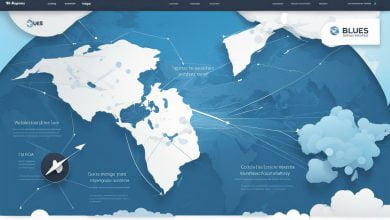
Welcome to our friendly guide on mastering Azure AD Domain Services. Azure AD Domain Services is a cloud-based service that provides managed domain services such as domain join, group policy, LDAP, and Kerberos/NTLM authentication. It allows you to manage and secure your cloud operations effectively and efficiently. In this section, we will introduce you to the basics of Azure AD Domain Services, including its purpose, benefits, and key features.
Key Takeaways
- Azure AD Domain Services provides managed domain services in the cloud.
- It allows you to manage and secure your cloud operations efficiently.
- It supports domain join, group policy, LDAP, and Kerberos/NTLM authentication.
Understanding Azure AD Domain Services
If you’re familiar with Active Directory Domain Services (AD DS), you’ll quickly understand what Azure AD Domain Services is all about. Azure AD Domain Services is a cloud-based alternative to AD DS, designed to provide all the benefits of traditional AD DS without the need for on-premises infrastructure.
Unlike traditional AD DS, Azure AD Domain Services is managed by Microsoft and can be used to manage users, devices, and applications in the cloud. This eliminates the need for complex and costly networking infrastructure and provides a seamless experience for managing your cloud environment.
Azure AD Domain Services uses domain controllers, just like traditional AD DS, to manage authentication and other domain services. However, the domain controllers are hosted in Azure, ensuring that all domain services are easily accessible from anywhere in the cloud.
How Azure AD Domain Services Works with AD DS
Azure AD Domain Services is designed as a complement to AD DS, allowing organizations to extend their existing on-premises directories to the cloud. To achieve this, Azure AD Domain Services synchronizes with your on-premises AD DS environment, allowing you to use the same credentials and access controls for both environments.
With Azure AD Domain Services, you can join Azure VMs to a managed domain, allowing for seamless integration between your on-premises environment and the cloud. This enables you to run applications and services in the cloud, while still maintaining the same level of security as your on-premises environment.
For organizations that don’t have an existing on-premises directory, Azure AD Domain Services can be used as a standalone directory service, providing all the benefits of traditional AD DS without requiring any additional infrastructure.
Setting Up Azure AD Domain Services
Setting up Azure AD Domain Services is a straightforward process that involves creating and managing an Azure managed domain and configuring domain controllers in the Azure environment. Here are the steps involved:
Create an Azure Managed Domain
The first step in setting up Azure AD Domain Services is to create an Azure managed domain. This can be done by following these steps:
- Sign in to the Azure portal.
- Select the Azure Active Directory service.
- Click on Domain Services in the left-hand menu.
- Click on Add Domain Services.
- Enter a DNS domain name. This should be a subdomain of your verified domain or a new domain that you own.
- Select the virtual network where you want to deploy domain services.
- Choose the IP address range that you want to use for domain controllers.
- Click on Domain Administrators to add user or group accounts that will have administrative privileges to manage your domain.
- Click on Review + Create, and then click on Create.
Your Azure managed domain will now be created, which typically takes a few minutes.
Configure Domain Controllers
After creating the Azure managed domain, the next step is to configure domain controllers in the Azure environment. This can be done by following these steps:
- Sign in to the Azure portal.
- Select the Azure Active Directory service.
- Click on Domain Services in the left-hand menu.
- Select your Azure managed domain.
- Click on Connect to virtual network.
- Choose the virtual network where you want to deploy domain controllers.
- Choose the subnet where you want to deploy domain controllers.
- Select the DNS servers for your domain.
- Click on Review + Create, and then click on Create.
With these steps, you can set up Azure AD Domain Services and configure the necessary components to manage your domain services efficiently.
Securing Your Azure AD Domain Services
When it comes to Azure AD Domain Services, security should always be a top priority. There are several important features and best practices that can help you keep your domain safe. Let’s explore some of them in detail.
Authentication Methods
One of the most important security considerations for Azure AD Domain Services is authentication. Azure AD Domain Services supports several authentication methods, including cloud-only credentials, password hash synchronization, pass-through authentication, and federation with on-premises Active Directory.
Cloud-only credentials are created and managed entirely in the cloud, providing a simple and secure way to manage user authentication. Password hash synchronization allows organizations to synchronize their on-premises Active Directory user passwords with Azure AD Domain Services, simplifying the user experience and enhancing security. Pass-through authentication provides a way to securely authenticate users against on-premises Active Directory without the need for password hash synchronization. Federation with on-premises Active Directory allows for more complex authentication scenarios, such as single sign-on.
Access Control
Access control is another critical component of Azure AD Domain Services security. Access control allows you to define who can access your domain and what they can do once they’re in. In Azure AD Domain Services, access control is managed through Azure AD, which provides a range of tools for managing access, including role-based access control (RBAC).
With RBAC, you can create custom roles and assign them to users or groups, granting them permissions to perform specific actions or access specific resources. By carefully managing access control, you can minimize the risk of unauthorized access and limit the potential impact of security breaches.
Securing Domain Controllers in Azure
Securing domain controllers is another important aspect of Azure AD Domain Services security. In Azure, domain controllers can be deployed in a number of ways, including as virtual machines (VMs) or on Azure Dedicated Hosts.
Regardless of how you deploy your domain controllers, there are several best practices you should follow to ensure their security. For example, you should always keep your domain controllers up to date with the latest security patches and updates. You should also implement encryption to protect sensitive data, such as user passwords, and use firewalls to limit access to your domain controllers.
By following these security best practices and leveraging the authentication and access control features of Azure AD Domain Services, you can keep your domain secure and minimize the risk of security breaches.
Managing Users and Groups with Azure AD Domain Services
Azure AD Domain Services provides a user-friendly experience for managing users and groups in your cloud environment. With Azure AD DS, you can create and manage users and groups in an Azure managed domain, making it easy to synchronize with on-premises Active Directory. Here’s a guide to help you get started.
Creating Users in Azure AD Domain Services
To create a new user in Azure AD DS, navigate to the Azure portal and select Azure AD Domain Services. From there, select Users and Groups, and then click on New User. Enter the user’s details, such as their name, display name, and email address. You can also assign roles and groups to the user for access control.
Managing Groups in Azure AD Domain Services
Azure AD DS also offers robust group management capabilities. You can create and manage groups in an Azure managed domain, making it easy to synchronize with on-premises Active Directory. To create a new group, navigate to Azure AD Domain Services and select Users and Groups. From there, click on New Group and enter the group’s details, such as its name and description. You can also assign members to the group for access control.
Synchronizing Users and Groups with On-Premises Active Directory
One of the key advantages of Azure AD Domain Services is its ability to synchronize users and groups with on-premises Active Directory. This allows for consistent user and group management across both on-premises and cloud environments. To synchronize users and groups, navigate to Azure AD Connect and configure the synchronization settings. This will ensure that any changes made to users and groups in one environment are reflected in the other.
Managing Azure AD Domain Services Pricing
When managing users and groups with Azure AD Domain Services, it’s important to keep pricing in mind. Azure AD DS is priced based on the number of directory objects, such as users and groups, that are created in your Azure managed domain. Be sure to monitor the number of directory objects to avoid unexpected charges.
Integrating Azure AD Domain Services with Other Azure Services
Azure AD Domain Services is a powerful tool that can be used in conjunction with other Azure services to enhance the overall functionality and management experience. By integrating with other services, you can maximize the potential of your domain management and take advantage of the benefits offered by other Azure solutions.
One of the key benefits of Azure AD Domain Services is its ability to integrate seamlessly with Azure Virtual Machines. By joining your virtual machines to your Azure managed domain, you can easily manage and authenticate users and resources across your entire environment. Additionally, Azure AD Domain Services can be used in conjunction with Azure App Service to provide secure, scalable web applications with integrated authentication.
If you’re using Azure Kubernetes Service, Azure AD Domain Services can also be integrated with your Kubernetes cluster to create a secure and scalable container environment. By leveraging Azure AD Domain Services for authentication and authorization, you can streamline development and deployment tasks, while also ensuring the security and compliance of your containerized applications.
Azure Active Directory Domain Services Pricing
It’s important to note that while Azure AD Domain Services offers many benefits, there are also costs associated with using this service. The pricing for Azure AD Domain Services is based on the number of objects in your directory and the number of authentication requests made to the service. You can find more information on Azure Active Directory Domain Services pricing on the Azure pricing page.
In conclusion, by integrating Azure AD Domain Services with other Azure services, you can unlock the full potential of your cloud environment. Whether you’re using Virtual Machines, App Service, or Kubernetes, Azure AD Domain Services provides a seamless and secure way to manage and authenticate users and resources across your entire infrastructure.
Monitoring and Troubleshooting Azure AD Domain Services
When it comes to managing your Azure Active Directory Domain Services, it’s important to have a solid monitoring and troubleshooting plan in place. This ensures that any issues are quickly identified and resolved, helping to maintain optimal performance and uptime for your domain services.
One of the key tools for monitoring your Azure AD Domain Services is Azure Monitor. This provides a centralized location for viewing logs and metrics, allowing you to proactively monitor your domain services for any potential problems. You can also set up alerts to notify you of any issues, ensuring that you can resolve them as quickly as possible.
In addition to Azure Monitor, you can also use Azure AD Domain Services Health Monitoring. This provides an overview of the health and status of your domain services, including any recent changes or updates. It’s also worth regularly reviewing your Azure AD Domain Services logs to identify any potential issues or errors.
When troubleshooting your Azure AD Domain Services, it’s important to have a clear understanding of the architecture and components involved. This includes your Azure domain controller, DNS resolution, and any relevant network configurations. You can use tools like Azure Network Watcher to help diagnose network issues, while the Azure Portal includes a variety of troubleshooting guides and resources.
If you encounter any issues that you’re unable to resolve on your own, the Azure support team is always available to help. They can provide expert guidance and assistance, helping to ensure that any issues are resolved quickly and effectively.
Conclusion
Mastering Azure AD Domain Services is essential for effective cloud operations and security. With its robust capabilities for user and group management, seamless integration with other Azure services, and comprehensive security features, Azure AD Domain Services offers a complete solution for domain management.
By following the steps we’ve outlined for setting up, securing, and managing Azure AD Domain Services, you can streamline your cloud operations and ensure the health and performance of your domain services. Whether you’re managing a small business or a large enterprise, Azure AD Domain Services offers the flexibility and scalability to meet your needs.
Start exploring the power of Azure AD Domain Services today and take your cloud operations to the next level!
FAQ
Q: What is Azure AD Domain Services?
A: Azure AD Domain Services is a cloud-based service provided by Microsoft Azure that allows you to manage and secure your domain operations in the Azure environment. It provides a fully managed domain controller as a service, eliminating the need for you to deploy and maintain your own domain controller infrastructure.
Q: What are the benefits of Azure AD Domain Services?
A: Azure AD Domain Services offers several benefits, including simplified domain management, enhanced security features, and seamless integration with other Azure services. It allows you to leverage your existing domain knowledge and tools while extending it to the cloud environment.
Q: How do I set up Azure AD Domain Services?
A: Setting up Azure AD Domain Services involves a few simple steps. First, you need to create an Azure managed domain. Then, you will need to configure the necessary components, including DNS and network settings. Finally, you can add domain controllers in the Azure environment to manage authentication and authorization.
Q: What security features does Azure AD Domain Services offer?
A: Azure AD Domain Services offers various security features to ensure the protection of your domain services. It includes built-in firewall rules, network isolation, and secure communication channels. Additionally, you can implement access control policies, multi-factor authentication, and monitor security logs for potential threats.
Q: Can I manage users and groups with Azure AD Domain Services?
A: Yes, Azure AD Domain Services provides robust user and group management capabilities. You can create and manage users and groups directly in the Azure portal, and they can be used for authentication and authorization across your Azure resources.
Q: How can I integrate Azure AD Domain Services with other Azure services?
A: Azure AD Domain Services can be seamlessly integrated with other Azure services to enhance their functionality. You can use it in conjunction with services like Azure Virtual Machines, Azure App Service, and Azure Kubernetes Service to simplify authentication and domain management.
Q: How can I monitor and troubleshoot Azure AD Domain Services?
A: Azure provides various monitoring tools and practices to ensure the health and performance of your domain services. You can use Azure Monitor to track metrics and set up alerts. In case of troubleshooting, you can analyze the logs and use diagnostic tools provided by Azure to identify and resolve any issues.







